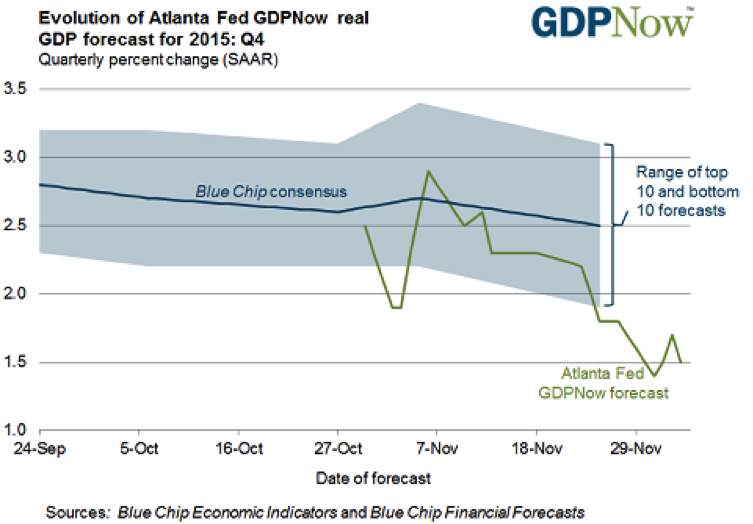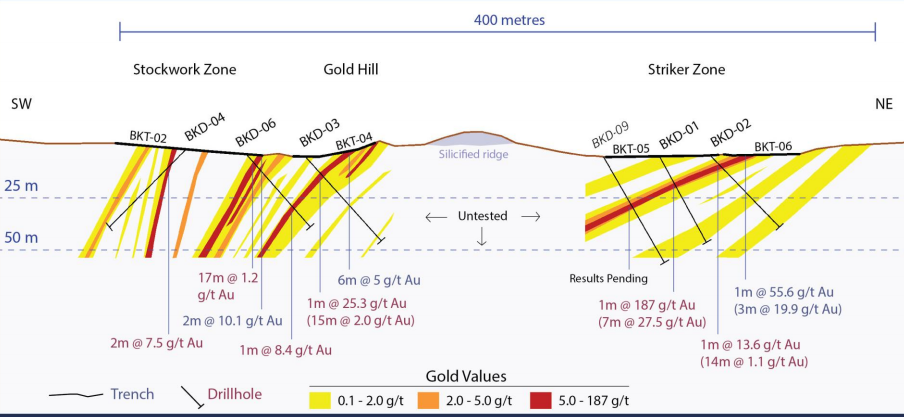
Maven Mondays: December 14, 2015
Rockhaven adds ounces; exploration efforts pay for Erdene; Amarc cuts copper at Ike; Anglo changes everything.
December is traditionally a quiet month for mining. Investors and bankers head off of holidays and companies hold off on releasing news.
But this year is a bit different.
Wednesday is the big day: the day we find out if the Federal Reserve is raising interest rates. Why would it do so? Ostensibly because the data says it should.
Well, one data point lines up with what Yellen said she needed to see before tightening, which is unemployment down to 5%. GDP growth is debatable: the analyst average is just shy of 2.5% but GDP Now, the real time forecast published by the Atlanta Fed, has it at 1.4%. Yellen said she wanted 4% GDP growth.

Then there’s inflation, which fell to 0.2% as of the mid-November Fed reading. Yellen wanted 2%.
So the data doesn’t really say rates should go up, but the Fed’s (1) need to retain some credibility after promising a rate hike for so long and (2) need to create some breathing room should easing become necessary mean it will happen. At least, that’s what I think.
Is it a good idea? No. The strong dollar is crimping US exports. Retailers are struggling under piles of excess inventory. Both of those have manufacturers suffering – November manufacturing contracted at the fastest pace since 2009. Energy investments are dead, what with oil worth just US$38 a barrel.
Rail traffic is a good indicator of US economic strength and the news there is not nice. US railroads have posted a 5.1% drop in carloads since the start of October, adding to decreases of 1.6% in the third quarter and 1.8% in the second quarter.
I think the US economic is weakening and a rate raise will hasten its decline.
Whether that is the case or not, if Yellen raises rates do not assume the dollar will soar and gold sink. In fact, following the first increase of a tightening cycle the dollar usually rises for a short time and then falls. Gold does the opposite.
If that happens, it means a boost to kick start gold’s strongest season of the year: January. To that, this week’s macro article continued my Tax Loss Buying preparations with a recap of what I’ve gone through already plus a new candidate for consideration. With the rate decision and its fallout still to come it’s still not time to actually buy our tax loss candidates, but we are almost ready.
In The News
Rockhaven Adds Half a Million Ounces
Rockhaven Resources (TSXV: RK) punched 56 holes totaling almost 14,000 metres into its Klaza gold deposit in southern Yukon this summer and the effort has now added 503,000 oz. gold to the inferred count.
Klaza, an epithermal gold system contained in steeply dipping structures that slice through competent granodiorite, is now home to 9.4 million tonnes grading 4.48 g/t gold, 89 g/t silver, 0.95% zinc, and 0.75% lead. Contained metals stand at 1.36 million oz. gold, 27 million oz. silver, 198 million lbs. zinc, and 155 million lbs. lead.
Starting the exploration season, Rockhaven had to make some choices. There are almost a dozen structures tracked on surface, many of which have been minimally or not tested. Those that have remain wide open along strike and at depth.
So where was the company to focus? Deep drilling to follow up on a tantalizing deep hit at the end of the 2014 campaign? Strike extensions? New targets?
The answer was: mineable ounces. Klaza is still an early stage property, but the focus is still on defining a deposit that makes sense to mine. To that, Matt Turner and his team targeted areas along strike and adjacent to defined resource where they had hit mineralization before, but where the drill densities were insufficient to count towards the last resource estimate.

Initial Klaza resource plan view (January 2015)

Updated Klaza resource plan view (December 2015)
Compare the two plan views. The top one shows the initial resource, from January. Note how the initial resource only included Western Klaza, part of Central Klaza, Western BRX, and a single structure through Central BRX.
The bottom map shows the new resource. The update extends Central Klaza along strike, adds the BYG offshoot as well as an unnamed offshoot on the footwall side, extends Central BRX so much that it becomes Eastern BRX, and adds Pika parallel to BRX to the north and an unnamed structure parallel to BRX to the south.
Not visible in the plan view is that Rockhaven had similar success filling in gaps and adding ounces at depth.
Rockhaven’s approach this summer made good sense. It was tempting to drill another deep hole, because the geologic concept is that Klaza is a particular kind of epithermal gold deposit known as a Carbonate Base Metal (CBM) deposit. The key characteristic of CBM deposits is that, unlike most epithermal zones that pinch out and disappear only a few hundred metres underground, CBMs can have very deep roots. Other CBMs have been mined to a kilometer depth.
Proving Klaza has that kind of depth potential would be great – but deep holes are expensive, difficult, and prone to miss, and one or two deep intercepts would not be sufficient to count towards the new resource anyway.
So Turner and his team made the sensible choice to chase attainable ounces, and attain them they did.
Now they are using the new resource to support a preliminary economic assessment, due out in the first quarter of 2016. While there is no actual plan to mine this thing anytime soon, it is important to demonstrate that Klaza is an economic deposit.
Matt can talk till he’s blue in the face about how Klaza is road accessible, how the terrain is gentle, how the host granodiorite would be a competent host rock for an underground operation, how the mineralization responds well to sequential flotation followed by pressure oxidation and leaching of the arsenopyrite concentrate to recover gold, and how despite being in the Yukon Klaza is in good proximity to infrastructure – but his talk won’t get much traction until he produces a PEA to back it all up. And traction will be important, as Rockhaven will need to raise money before next summer.
Congrats to Rockhaven on a job well done.
———————————————-
Erdene Hits High Grade in Mongolia
So great when the process works.
In the spring Erdene Resource Development (TSXV: ERD) ran an initial exploration campaign on the southern part of its Khundii license, in south-central Mongolia. The work outlined the Bayan Khundii gold target, comprising two mineralized zones along 1.4 km of northeast strike.
In the summer 11 trenches on the Main zone returned promising results, such as 30 metres of 2.7 g/t gold and 1 metres of 55.6 g/t gold.
By the fall Erdene was ready to drill and punched 15 angled core holes into the zone. The holes were relatively short, maxing out at 70 metres and averaging 46 metres.
Results are in for the first six holes, which have already outlined five zones of high-grade gold within broad, lower-grade mineralization, all starting at surface.

Results included:
- 27.5 g/t gold over 7 metres, including 187 g/t over 1 metre
- 2 g/t gold over 15 metres
- 1.2 g/t gold over 17 metres, including three high-grade 1-metre intercepts (5.1 g/t, 6 g/t, and 8.4 g/t)
Erdene reported that step-out holes still at the assay lab cut visible gold, suggesting the next set of results could be equally interesting.
The gold is sitting in zones of quartz breccia and comb-quartz veining within silica and sericite altered volcanic host rocks. Several of the assayed intercepts included visible gold. Gold is concentrated in the quartz veins, though the host rocks also run.
“The strong, pervasive alteration and the extensive presence of primary hematite indicate a large intense alteration system that has positive implications for the potential size of the system,” Erdene said. It is important to take such statements for what they are, which is a biased idea based on limited information. However, the technical team at Erdene is very strong, which lends weight to the idea.
Erdene’s share price gained a penny on the news to close at $0.13. The company has 105 million shares outstanding. Khundii is one of five properties that Erdene is advancing in Mongolia, including the advanced-stage Altan Nar project.
———————————————-
Amarc Cuts Long Copper at Ike
Amarc Resources (TSXV: AHR) is another example of the persistence needed to keep exploring in these markets. Headed by long-time Hunter Dickinson geologist Diane Nicholson, group founder Bob Dickinson, and proven manager and financier Ron Thiessen, Amarc is advancing Ike, a copper porphyry discovery in south-central British Columbia.
Diane and Bob introduced me to Ike earlier this year, at PDAC. By then the company had already drilled nine holes. That program demonstrated the potential for scale at Ike, with all holes returning chalcopyrite and molybdenum over long intercepts.
At that time Bob’s belief in the asset was clear, from both his exuberance and the million dollars he had loaned to Amarc to get things going. Loans aren’t a sustainable funding mechanism, so Amarc set to work finding one that was.
In September they sealed a deal with Thompson Creek Metals, which is now earning a 30% stake in Ike by funding $15 million worth of work on the property within four years. Amarc remains operator.
Amarc and Thompson Creek went to work immediately, drilling another nine holes totaling 5,028 metres in just 22 days. Again, every hole returned chalcopyrite and molybdenum.
The area of mineralization now measures 1km by 1.2 km by 500 metres deep. Highlights from the newest nine holes include 124 metre grading 0.34% copper, 0.022% moly, and 3.2 g/t silver and 592 metres carrying 0.3% copper, 0.032% moly, and 2.1 g/t silver.
Those aren’t knock-your-socks-off grades, but as Amarc likes to point out they are the kinds of grades that underlie most major mines in BC. Case in point: Mt Milligan, a Thompson Creek mine built on a Hunter Dickinson group discovery, taps into ore averaging 0.2% copper and 0.355 g/t gold.
Now Amarc and Thompson Creek are busy planning a 2016 program. The partners will spend about $3 million. Large, lower grade deposits like these take a long time to explore, engineer, permit, and build and it’s good to see two groups with experience doing just that working together to get Ike going despite the downturn.
———————————————-
Anglo Changes Everything
From the majors this week…restructuring and dividend cuts. Anglo American (LSE: AAL) stole the spotlight (not in a good way) with news of a radical restructuring.
The company is putting 35 of its 55 assets up for sale to focus on “priority 1 assets that deliver free cash flow through the cycle”. The divestments will slash Anglo’s workforce from 135,000 now to 92,000 in 2017 and 50,000 beyond that. The company’s remaining operations will fall into three categories: DeBeers (diamonds), industrial metals (platinum and base metals), and bulk commodities (coal and iron ore).
Anglo hopes to bank US$4 billion from the asset sales. The company will identify which mines will be sold or shuttered in February, though it is clear that newly added to the sale list are Anglo’s phosphates and niobium divisions.
Capex has been cut again, to now stand at US$2.9 billion between now and the end of 2016 and US$2.5 billion in 2017. Those sound like sizeable numbers, but in fact those are the capital investments needed to keep Anglo’s operations going.
The dividend is going too. No dividend from Anglo in the second half of 2015 or anytime in 2016.
The company’s big burden is debt. Anglo carries US$12 billion in debt, down a few billion over the year but still high relative to its US$7.7-billion market cap.
With so much debt, a share price that has fallen dramatically this year, and a foundation in the worst performing commodities out there – iron ore and coal – Anglo needed a new plan.
However, the market seemed shocked by the scale of the restructuring and how suddenly it was presented.
Anglo’s share price lost as much as 15% in intraday trading on the news, and while it recovered a good chunk of that the loss extended its year-to-date losses to almost 75%. Anglo now sits ahead of Glencore as the worst performing stock on the FTSE 100 index of major U.K. equities.
The team at SP Angel, a brokerage in London that puts out a nice metals market note every morning, summed up reaction to the announcement nicely:
“It’s as though Anglo decided to implement every rationalization ever conceived all at once in some massive realization of what might happen if commodity prices remain at current levels for the next few years… Anglo appears to be closing in on the Selling part of a BUY high SELL low strategy.”
In the wake of Anglo’s big announcement, it was easy to miss Freeport McMoRan’s news that it too is suspending its dividend. The move will save FCX some US$240 annually, though investors grieved the loss of most of the dividend back in March when Freeport slashed it from US$0.3125 to US$0.05 quarterly.
———————————————-
Tax Loss Buying Part IV: Recap & Another Candidate
Let’s review our tax loss buying arguments and requirements.
- TSX stocks down more than 15% from January 1 to mid-November underperform the index by some 4% over the tax loss selling month of mid-November to mid-December.
- Those stocks then outperform the index by almost 4% between mid-December and mid-January.
- Gold has a very reliable strong season to start the year. That strength means gold miners already rise mid-December to mid-January; the outperformance in point #2 is on top of that.
Put that together and it says: use the time between mid-November and mid-December to identify potential tax loss buying candidates. Be ready, but don’t buy until mid-December. And buy with a plan – a percent gain or a January date – to get back out, because this is a seasonal play and the season will end.
The next step is then identifying candidate stocks. The requirements are:
- Stocks down more than 15% year-to-date as of mid-November.
- Commodity: gold. Silver too, if you like, but of all metals gold offers the most reliable seasonal rally.
- Companies that have faced specific struggles on which progress or resolution is on the horizon. The struggle helps explain why the stock is down year-to-date despite the company being fundamentally sound. Resolution or progress towards resolution could amplify seasonal gains.
I have looked at three potential candidates already: Mandalay Resources (TSX: MND), Tahoe Resources (TSX: THO), and Primero Mining (TSX: P). All three met all three criteria. Since writing about each, one has continued to decline (in line with tax loss selling expectations) while the other two have gained.
In last week’s letter I reviewed those three candidates and then outlined a fourth. We will select our final targets and place orders next week. If you’d like to play along, click here and sign up for a free trial subscription.
Resource Maven finds and explains the news that matters in the world of resource exploration and development.
Click HERE to have Maven’s mining news emailed to you.
Or follow Maven on Twitter: @miningmavengwen
To learn how to turn resource knowledge into investment success: subscribe to Resource Maven.



